A Self-Guided Walking Tour of Galway for First-Timers
With a rich historic heritage and compact size, Galway is best to visit on foot. With this self-guided walking tour of Galway, explore the medieval streets and historic monuments of this bustling capital of the West of Ireland.
This itinerary will take you to Galway’s not-to-be-missed attractions, including the vibrant Latin Quarter filled with colourful pubs and boutiques, the city’s modern cathedral and the magnificent 19th century university. It is a great introduction to the city if you are visiting Galway for the first time.
Allocate 2 to 3 hours of your time to this tour if you want to explore shops and monuments along the way. You might even be tempted to stop for a restorative coffee and snack as you wander the cobbled streets of medieval Galway.
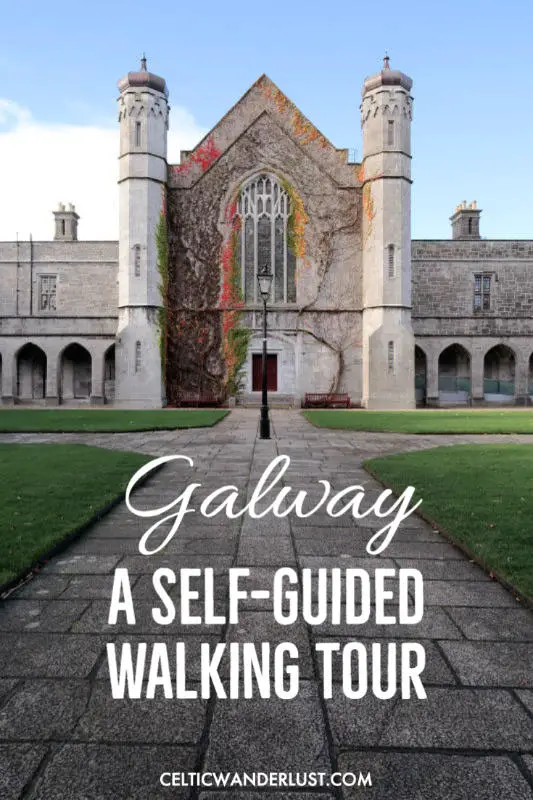
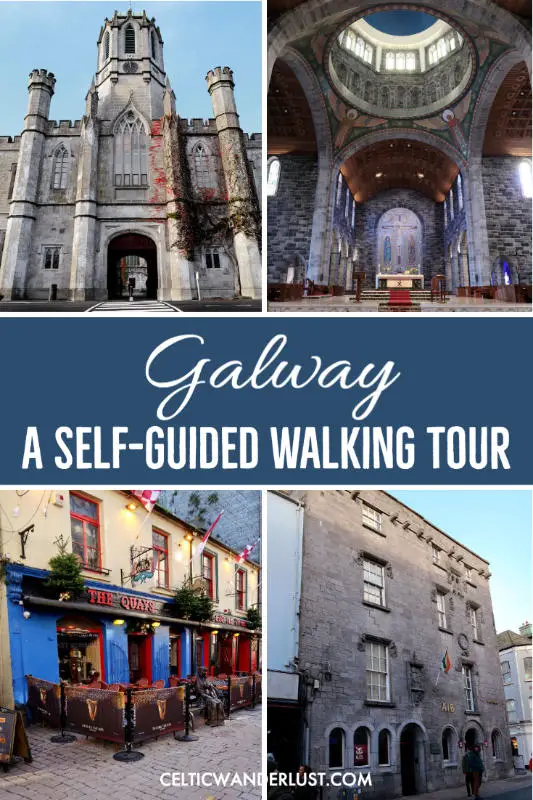
- Start Your Self-guided Walking Tour of Galway in Eyre Square
- Stroll Down Galway’s Lively Latin Quarter
- Take a Walk along the River Corrib
- Take a Peek Inside Galway Cathedral
- Admire the Quadrangle’s splendid architecture
- Stop by the Lynch Memorial Window
- End Your Self-Guided Walking Tour of Galway at the Collegiate Church of St. Nicholas
Map of Your Self-Guided Walking Tour of Galway
Start Your Self-guided Walking Tour of Galway in Eyre Square
Whether you are travelling by bus or by train to Galway, chances are you will be starting your self-guided walking tour of Galway in Eyre Square. Galway train station as well as the city bus station are just around the corner from this popular meeting place.
At the heart of the city, Eyre Square is dominated by the Quincentennial Fountain, a piece of abstract art erected in 1984 for Galway’s 500th anniversary as a city. The structure represents the sails of the hooker boats, traditional fishing vessels that were in use in the area.
On its south side, the Hardiman Hotel has been standing proudly over the square since the mid-nineteenth century. The luxurious and grand-looking hotel has been hosting celebrities and dignitaries since its opening, starting with Prince Louis Napoleon of France in 1857.
West of the square, you will find the entrance to the Eyre Square Centre, Galway’s main shopping centre. Further up the street, the Skeffington Arms Hotel has welcomed hungry passers-by for some hearty pub food and drinks since 1850.
Stroll Down Galway’s Lively Latin Quarter
As you leave Eyre Square by Williamsgate Street and head towards Shop Street, you enter the medieval part of the city. The pedestrian neighbourhood stretching from Shop Street to the left bank of the river Corrib is now known as the Latin Quarter. Filled with craft shops, boutique, cafés, pubs and buskers singing their hearts out, it is the most vibrant part of Galway.
The name “Latin Quarter” refers to medieval Galway which prospered up to the 17th century thanks to successful trade routes with the Iberia peninsula. The name was officially adopted by the neighbourhood in 2009.
As you stroll down the Latin Quarter’s cobbled streets, enjoy the pubs’ colourful facades that compete for your attention. Bright red, green or yellow, their quirkiness attracts countless visitors each year and are the perfect background for your pictures.
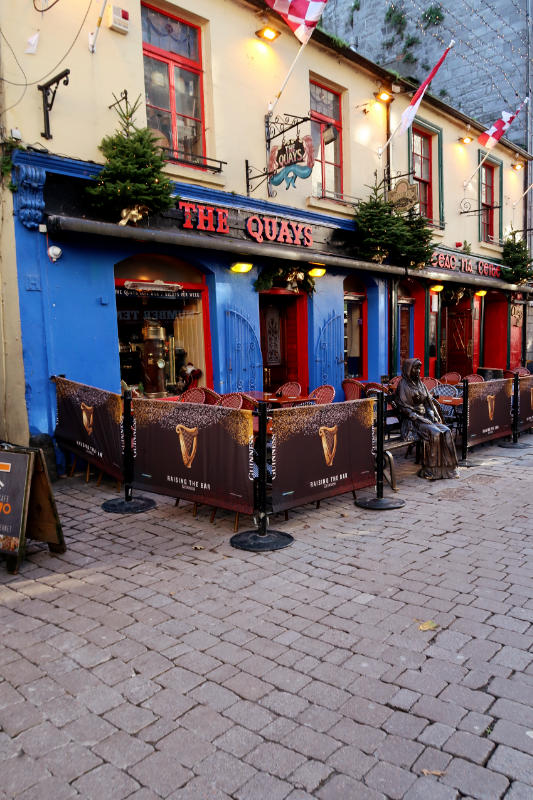
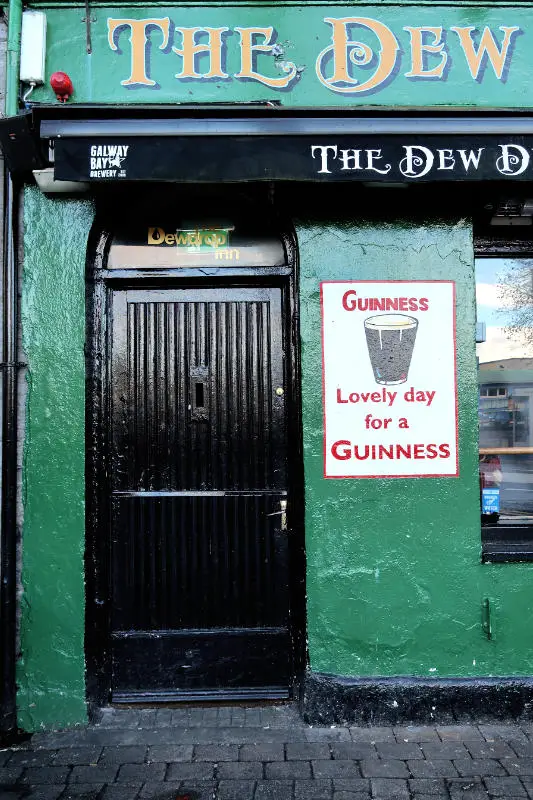
The area is also famous for its Claddagh ring jewellers. The traditional Irish ring, symbol of love, loyalty and friendship, is said to have been born in Galway some 300 years ago. Wander into some of the many shops selling the quintessential Irish jewellery, and you’ll perhaps be tempted to buy the perfect gift for yourself or a loved one.
Amongst interesting landmarks to be found in the Latin Quarter during your self-guided walking tour of Galway is Lynch’s Castle. Located at the corner of Shop Street and Abbeygate Street, the building’s architecture is absolutely striking. Lynch’s Castle is a great example of a 16th century fortified house. Adorned with magnificent carved windows and gargoyles, it was built by the Lynches, one of the 14 merchant families who receiving governing powers from Richard II in 1396. These powerful families were to be known as the 14 Tribes of Galway.
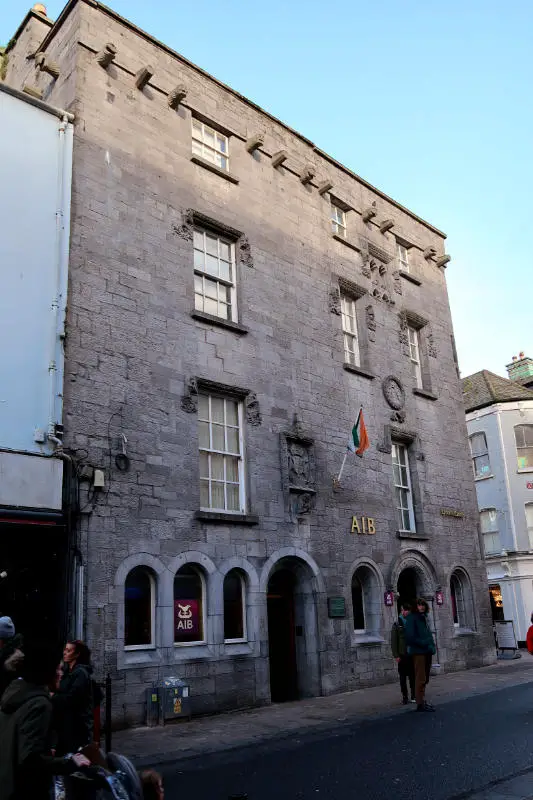
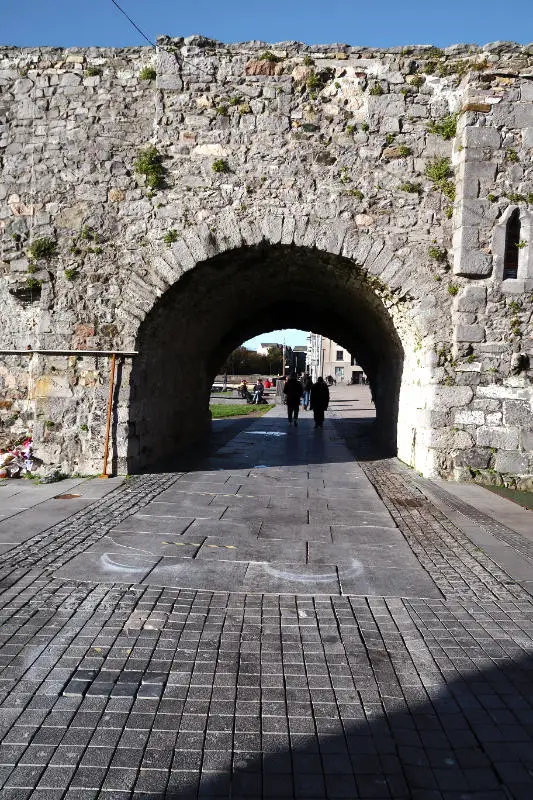
As you make your way to the bottom of the Latin Quarter, you will find the Spanish Arch on the bank of the River Corrib. The extraordinarily thick arches, built at the end of the 16th century, were an extension of the town wall to protect the quays from attacks. The Spanish Arch is a vivid reminder of what Galway used to be in medieval times: a walled city under constant threat of incursions by Gaelic clans. Its name is thought to be a reference to the Spanish ships mooring there when Galway was an important trading post in the West of Ireland.
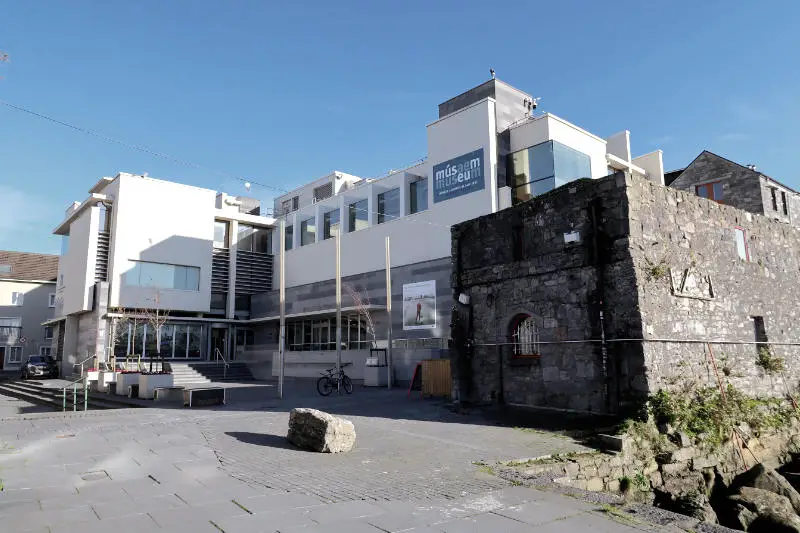
Just a few metres away from the Spanish Arch, Galway Museum is free to explore. The museum holds long-term and temporary exhibitions. I had the chance to see their wonderful exhibition on the Gaelic society and culture of the Middle Ages. I highly recommend it.
You might also be interested in:
– Bundoran: How A Remote Irish Village Turned International Surfing Destination
– A Beginner’s Guide to Surfing in Lahinch Beach, Ireland
– The Randles Hotel – Where to Stay in Killarney for a Luxurious Getaway in Co. Kerry
Take a Walk along the River Corrib
Now that you are on the bank of the River Corrib, take a moment to admire the view over the water and Galway Bay. Across from the Spanish Arch, on the other side of the river, lies the Claddagh. This modern part of Galway used to be a fishing village with thatched-roof cottages. The village gave its name to the famous ring. The cottages were unfortunately demolished at the beginning of the 20th century to make way for modern housing.
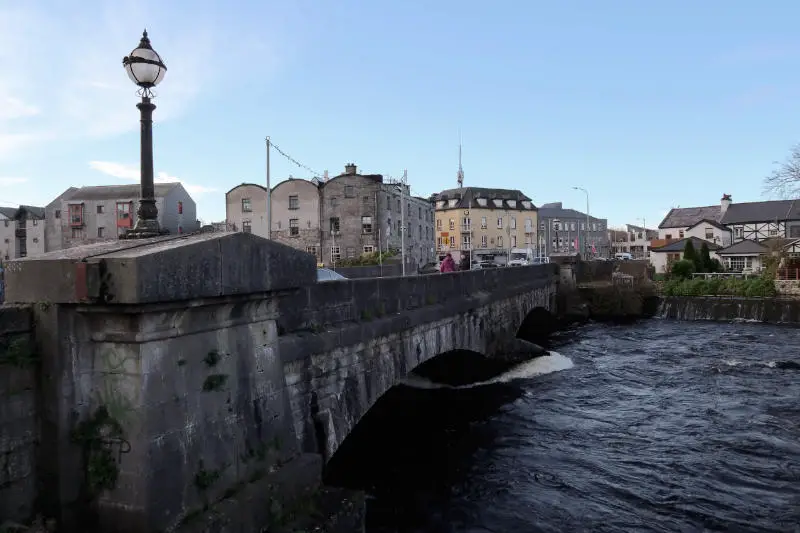
Only 6 kilometres long, the River Corrib is a short but powerful river that surges through the city and owes its name to Lough Corrib, a lake north of Galway. Three bridges span the river in the inner city. The first one is the Wolf Tone Bridge directly on your right.
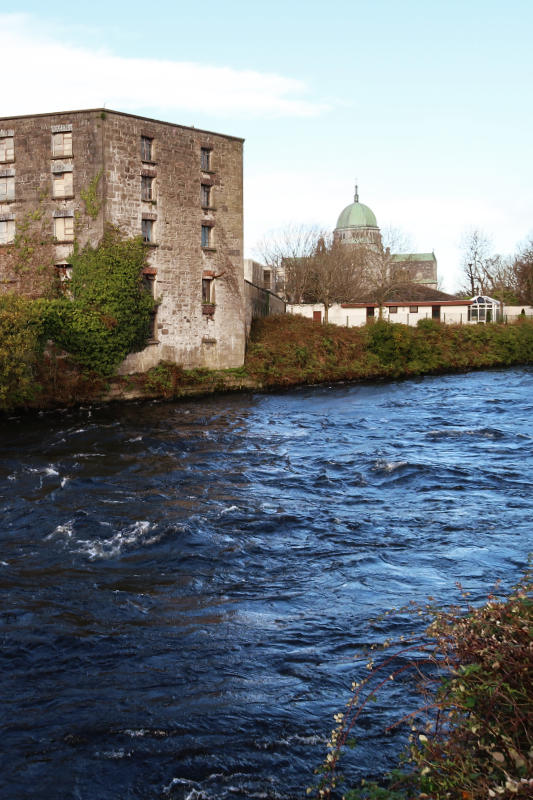
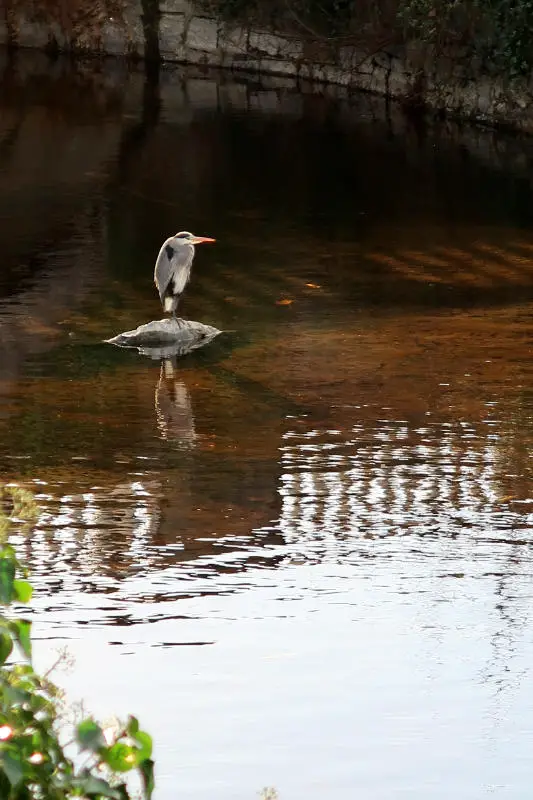
From there, you can follow a walking path along the river that would lead you to the second and third bridge, the Salmon Weir Bridge. The path makes for a quick but exhilarating walk along the rushing water of the River Corrib. If you are lucky, you could even see some wildlife. I caught sight of a graceful heron standing still in the water, on the lookout for its next meal.
Take a Peek Inside Galway Cathedral
Once arrived at the Salmon Weir Bridge, your next stop can’t be more obvious. Standing on the opposite side of the bridge, the Cathedral of Our Lady Assumed into Heaven and St Nicholas, also known as Galway Cathedral, is free to visit.
Built in the 1960s, the cathedral of Galway is one of the last cathedrals to be built in Europe. The Gaol Road at the back of the building is a reminder that it was erected on the site of a former prison.
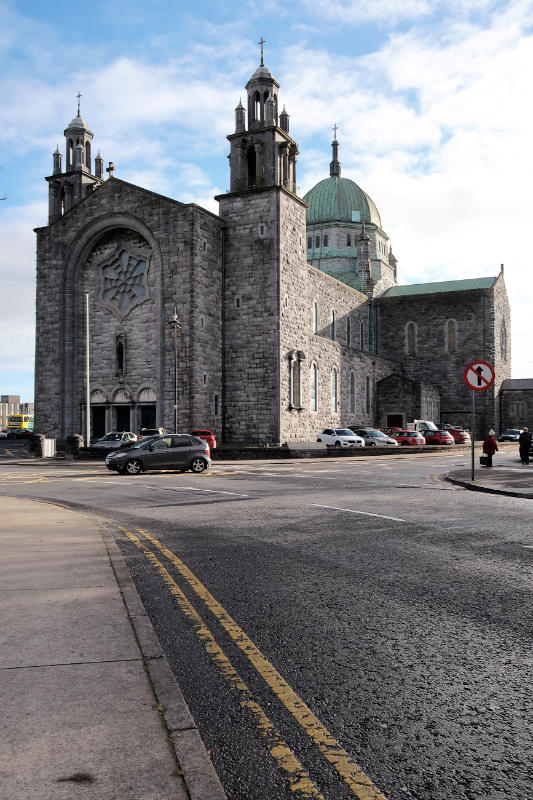
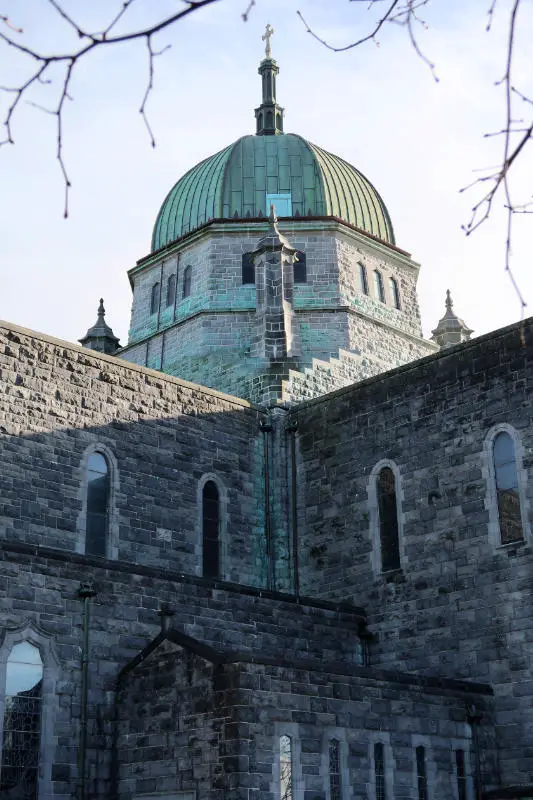
Its modern architecture has brought criticism, some calling it frankly “ugly”. Mixing different styles, the imposing building will certainly not leave people indifferent. Whatever your first impression is, don’t be fooled by its rather stern exterior.
Once inside, the nave is large and airy. Flanked by round arches drawing from the Romanesque tradition, the slightly curved, wooden ceiling contrasts with the grey limestone of the walls. The wooden pews echo the ceiling, bringing light and warmth to a building that could have been otherwise cold and joyless.
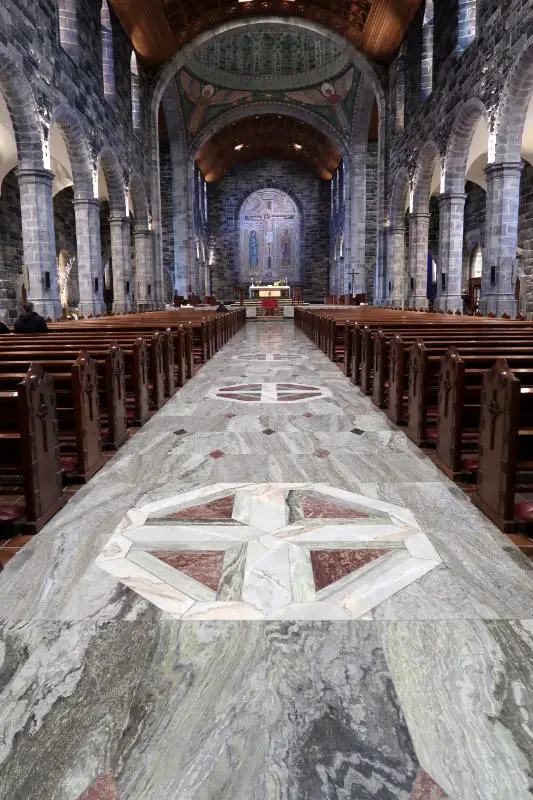
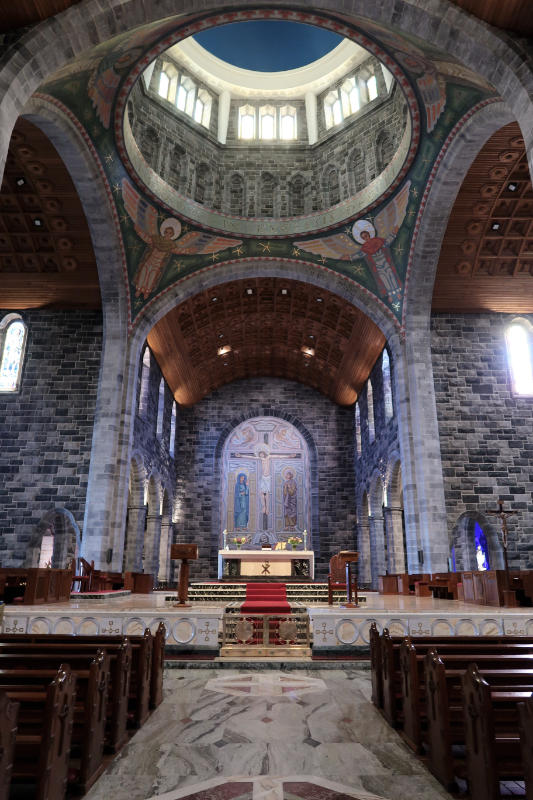
Eyes are drawn to the magnificent Renaissance dome framed by four angels spreading their wings all around it. Above the northern wall, a colourful rose window is framed by a pipe organ spanning the entire length of the wall, a modern piece of art floating in the air.
Admire the Quadrangle’s splendid architecture
From Galway Cathedral, follow University Road for just 500 metres, and you will soon catch a glimpse of the University of Galway’s oldest building. Known as the Quadrangle because of its shape, it was built in bold Tudor Gothic architectural style. Its construction started in 1846, and the building welcomed its first students in 1849.
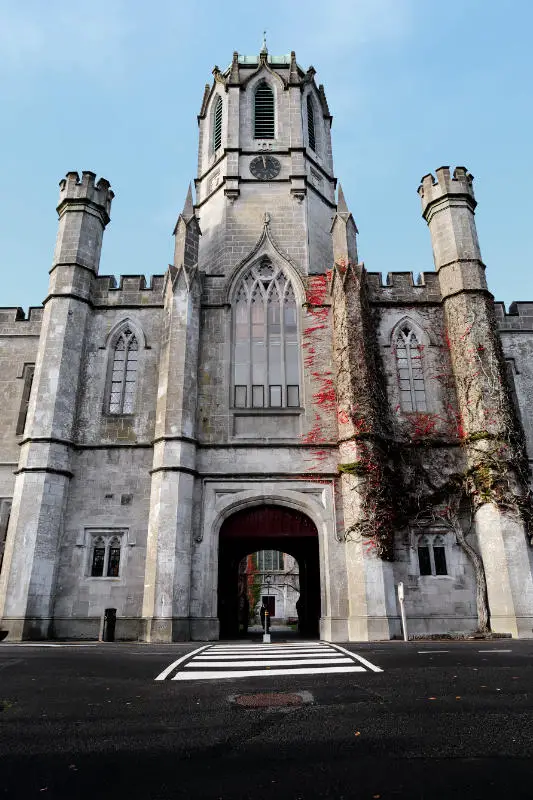
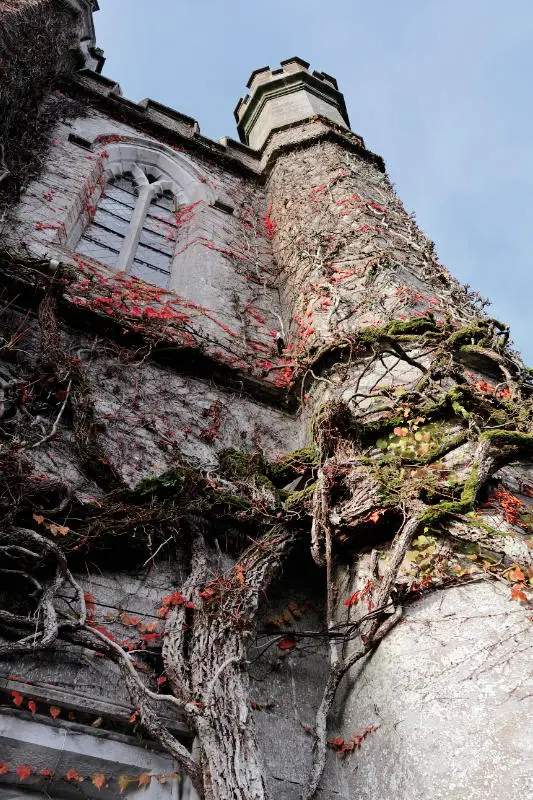
Founded as Queen’s College, the Quadrangle was modelled on Christ Church college at the University of Oxford. The rectangular building can be entered freely through an archway found on the East Wing, underneath a clock tower crowned by a green copper dome.
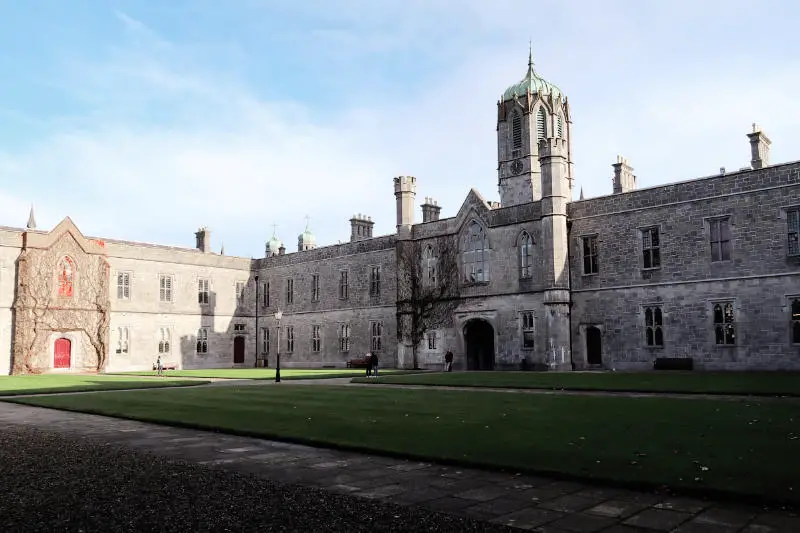
Inside the courtyard, you are left to face the stunning architecture surrounding you from all corners. The Aula Maxima, or Great Hall, occupies the centre of the West Wing, whose facade disappears under a thick blanket of ivy framing a splendid arched window. It is flanked with two thin octagonal towers crowned with copper, while arcades extend to both ends of the West Wing.
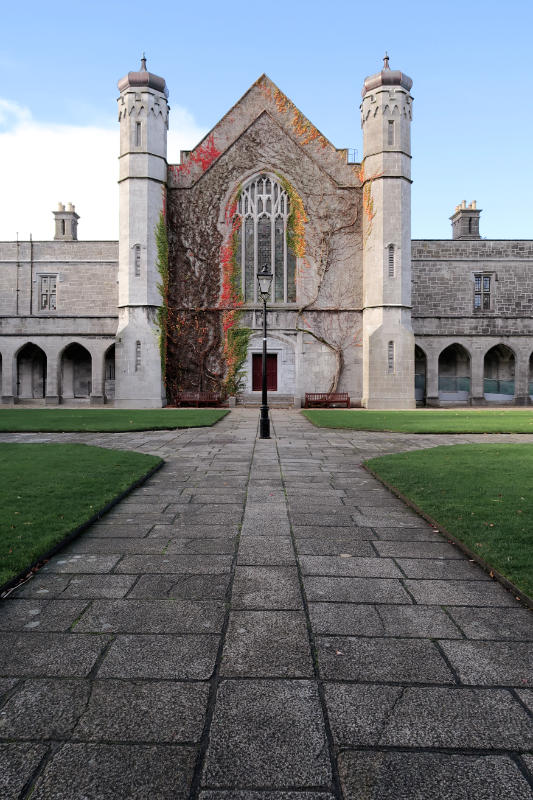
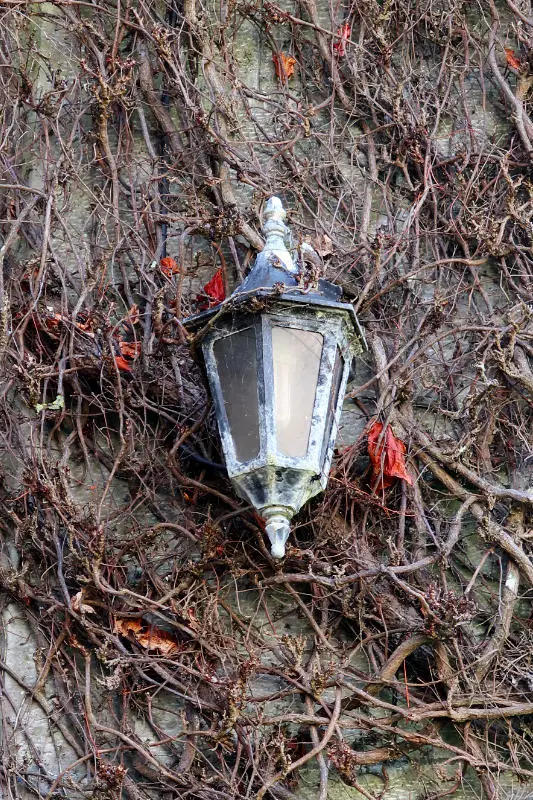
Wherever you look, the splendid building surrounds you with history, the ivy creeping around doors and windows, giving the place a timeless atmosphere. In keeping with its historic environment, an old lamppost borrowed from black and white movies, stands right at the centre of the courtyard, providing the final touch to this romantic place. Don’t miss it, even if you only have one day in Galway.
Stop by the Lynch Memorial Window
Now retrace your steps back to the cathedral and cross once again the Salmon Weir Bridge. Turn right after the bridge on Newtownsmith. Walk for another 5 to 10 minutes and take a right on Market Street. Here you will find the Lynch Memorial Window.
At first glance, what looks like the remains of an old house is in fact a monument to a rather spooky event that may, or may not, have happened in 15th century Galway.
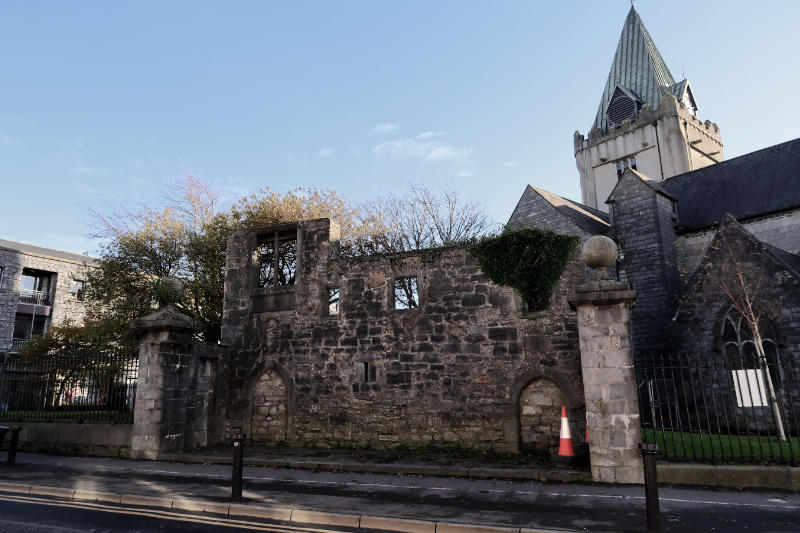
The story goes that in 1493 Walter, the son of James Lynch FitzStephen, mayor of Galway, was found guilty of murdering a Spanish merchant who has his eyes set upon Walter’s girlfriend.
Unable to find someone to carry out the death penalty, it is told that the principled mayor of Galway hung his son himself from a window of his own house. Although the house was not located in Market Street, the original window is said to be the one featured in the monument placed here in the 19th century. The ominous skull and crossbones carved under the window give the place a hair-rising touch that will stay with you for a little while.
True story or not, the fate of Walter Lynch, killed by his own father, gave us the well-known expression “to lynch someone”.
End Your Self-Guided Walking Tour of Galway at the Collegiate Church of St. Nicholas
At the back of the Lynch Memorial Monument, you will find Ireland’s largest medieval parish church. Founded in 1320, it is dedicated to St. Nicholas of Myra, the patron saint of sailors. In 1477, Christopher Columbus prayed here as he visited Galway.
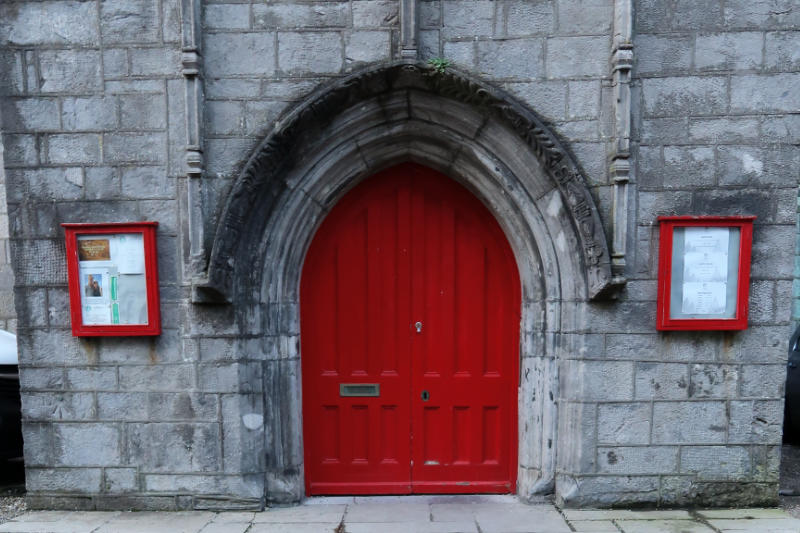
As you will see from the outside, the central part of the church has an unusual roof consisting of three pitched roofs. In the 16th century, the church was extended with two side aisles to the nave by the Frenches and the Lynches, two of the 14 Tribes of Galway, hence the church’s curious shape.
You are welcome to take a peek inside the church, which is open every day. Avoid service time though, so as to not disturb the parishioners. You will find interesting monuments and memorials, including the church’s oldest tomb dating from the 13th century.
Looking for guided-tours to learn more about Galway?
Check out this selection of top-rated tours, you might find something that fits your needs and interests :
If you are visiting Galway for the first time, exploring the city on foot should be on your to-do list. This self-guided walking tour of Galway should come handy if you wish to familiarize yourself with this charming city full of life and history. Galway is no doubt a popular destination, and for good reasons, so make sure to book your accommodation early if you are planning to stay the night.
Disclaimer: This post may contain affiliate links. If you click on a link, I earn a little money at no extra cost to you.
RELATED POSTS

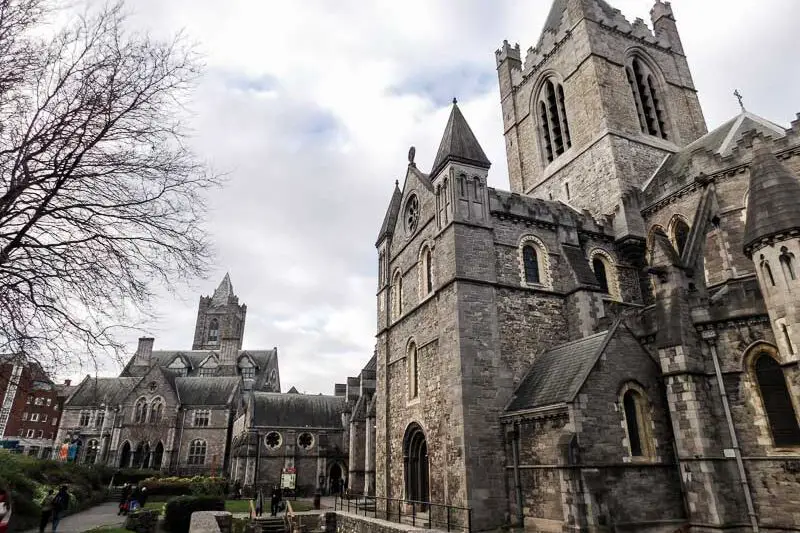

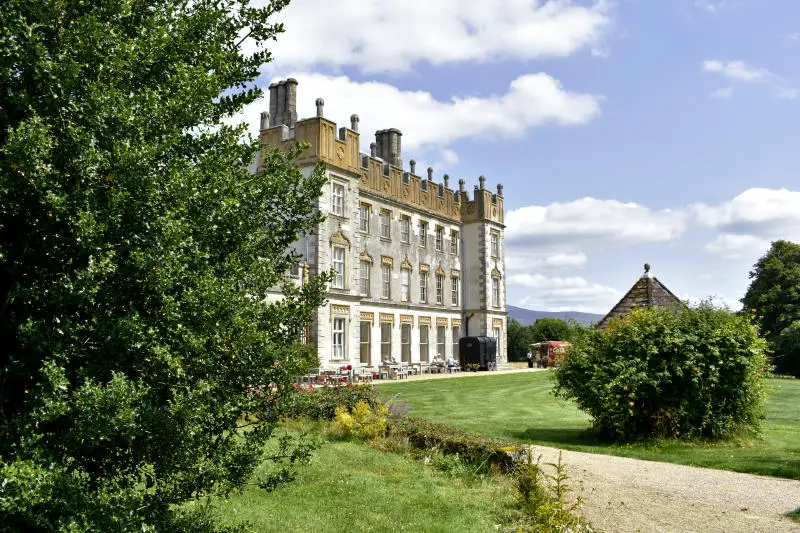
Fabulous walking tour of Galway. Very informative too. Thanks so much.
Glad you enjoyed Galway!